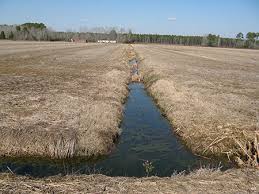Natural and artificial rainfall (irrigation) provide water to crops to support their growth and development. This water usually fills the pore spaces in the soil and is absorbed by plants through their roots.
When these pore spaces become saturated, excess water floods the soil surface and escapes through seepage, runoff, or drainage out of the field. This article discusses the drainage of water from the soil, whether due to rainfall or irrigation.
Read Also: 10 Medicinal Health Benefits of Podocarpus henkelii (Henkel’s Yellowwood)
Definition of Drainage in Agriculture

Drainage is the artificial removal of excess water from farmland to prevent waterlogging, enhance healthy plant growth, and support farming operations.
Drainage and irrigation are complementary practices, especially in arid regions where soils are easily eroded due to their loose structure.
Importance of Soil Drainage in Agriculture
1. It prevents waterlogging in the soil
2. It allows early planting and ploughing
3. It improves soil aeration
4. It raises the soil temperature
5. It supports the growth of soil bacteria and other soil organisms
6. It reduces soil acidity and salinity
7. It helps in leaching excess salts from the soil
8. It promotes seed germination
9. It increases the depth of the root zone, providing more available moisture and nutrients
10. It enhances decomposition of plant and animal residues
11. It increases water infiltration, reducing erosion risks
12. It extends the crop growing season
Read Also: General Principles of Goat Production
Types of Drainage Systems in Agriculture

There are two major types of drainage systems: surface drainage and sub-surface (underground) drainage. Drainage systems may also be grouped into gravity systems (surface and sub-surface) and pump systems (wells and sumps).
1. Surface Drainage System
Surface drainage involves removing excess water from the soil surface using constructed open ditches, field drains, land grading, and lateral ditches. Excess water flows from the farmland into these ditches and is channeled to an outlet such as a river or pond.
These are also referred to as open drainage systems, and are usually constructed to a minimum depth of 1 to 1.5 metres with a trapezoidal shape.
i. Advantages of Surface Drainage
1. Easy to construct
2. Lower initial cost compared to sub-surface systems
3. Prevents stagnant water
4. Capable of handling large volumes of water
ii. Disadvantages of Surface Drainage
1. Hinders the movement of farm machinery
2. Reduces available land for crop production
3. Requires high maintenance cost
4. Can serve as breeding grounds for pests and insects
5. Open ditches are prone to gully erosion
2. Sub-Surface or Underground Drainage System
Sub-surface drainage involves the orderly removal of excess water from farmland using materials like pipes, tiles, moles, and plastic tubes. The common method is the tile drain system, which consists of connected pipes forming a continuous line laid in narrow trenches.
These pipes have holes to allow water entry, and filter materials are placed around them to prevent clogging. Concrete and clay pipes are the most common tiles in irrigated regions.
In Asia, bamboo sticks are widely used and have proven suitable in some areas in Nigeria.
i. Advantages of Sub-Surface Drainage
1. Does not interfere with machinery movement
2. Low maintenance cost
3. Farming activities are uninterrupted
4. Does not reduce land available for production
5. Supports the cultivation of high-value crops
ii. Disadvantages of Sub-Surface Drainage
1. High installation cost
2. Possible clogging, leading to erosion
3. Heavy machinery may damage the drainage tiles
Other forms of sub-surface drainage include sumps and wells, which use pumps to remove water from collection points to a distant outlet or for irrigation. Sumps are constructed to a depth of about 6 metres to drain small waterlogged areas and can also serve as outlets for tile systems.
Small pumps are used to remove water from the sumps and return it upslope for reuse. This process conserves water and nutrients while eliminating drainage hazards.
When planning irrigation, consideration must be given to the management of excess water to avoid waterlogging.
The effectiveness of land drainage depends on the soil type and the amount of water received through rainfall and irrigation.
Do you have any questions, suggestions, or contributions? If so, please feel free to use the comment box below to share your thoughts. We also encourage you to kindly share this information with others who might benefit from it. Since we can’t reach everyone at once, we truly appreciate your help in spreading the word. Thank you so much for your support and for sharing!

